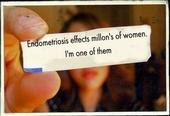Oprah,
I enjoyed your show last month on innovative ways to live longer. It gave me hope, hope that someday the disease that afflicts me will be better understood.
Seven years ago, I had intense pain in my pelvic cavity. After going to the emergency room, and eventually an OBGYN, I was told that I had a tumor or cyst on my ovary. I promptly scheduled surgery for the following week. The first thing I remember coming out was my mom telling me that it wasn’t a tumor, it was endometriosis. My heart dropped because I knew the type of tumor suspected was benign and had little chance of returning, but endometriosis has no cure and could mean a lifetime of pain, both emotionally and physically.
Endometriosis affects me almost every day. I recently underwent my third laparoscopy and have just started my second round of an experimental hormone therapy, Lupron. And, I’m not alone. According to the Endometriosis Association, Endometriosis “affects 5 1/2 million women and girls in the USA and Canada, and millions more worldwide.”
I could tell you about the immense amount of pain that I have been in most of my life, or the psychological damage of thinking that you are infertile and defective as a woman. But I won’t, because I’m one of the lucky ones. I recently gained health care to assist in the massive amount of medical bills. I don’t have any of the autoimmune diseases that tend to accompany endo like chronic fatigue syndrome, fibromyalgia and lupus. And probably the biggest reason I feel thankful, I still have my reproductive organs and a positive outlook for their future.
There are so many out there that are not as fortunate as myself. They suffer in ways that most couldn’t imagine or understand. One of the hardest obstacles we have to overcome is explaining to our family, friends and most importantly, ourselves the parameters of the disease. There are many theories including: Metaplasia—a form of embryonic tissue that transforms into reproductive organs, retrograde menstruation, genetic predisposition, immune system dysfunction, and environmental offenders. I believe that the truth lies in a combination of these theories.
As with their patients, most doctors don’t seem to completely get it either. The first group of doctors I went to only seemed to be concerned with me having children. I understand they meant well, but I was still in college, single and not ready to bring a child into this world, who I frankly couldn’t care for in the way they deserve. I now have an innovative set of doctors that have made my life more livable. My surgeon, Dr. Rakesh Mangal, was able to remove all of my endo and my appendix, which was suffocating in scar tissue. The doctor who I was referred to, Dr. John Mathias, is amazing! He has conducted his own research and discovered a course of treatment that both prevents the disease from returning and reduces pain through diet versus pain killers.
He believes that the colon is the “brain” of the endo and contributes to the growth as well as pain levels. Through his primary research, he found that women with endo have mini-seizures in their colon that aggravates and furthers the condition. He hooked my stomach up to a machine that measures seismic activity and let me listen to my tummy as it crunched each time it seized. He also found that woman with endo are insulin resistant and that sugar aggravates the condition and raises pain levels. I was completely amazed by his theories and his research.
He started out by providing a diet that I would consider a mix between a Mediterranean diet and the South Beach Diet, which basically includes fruits, vegetables, poultry, seafood and olive oil. He also has his patients take minerals and Omega-3, In addition, to medication to control the seizures and daily Lupron shots.
Lupron is an experimental hormone that tricks the woman’s body into artificial menopause with the intent to stop the production of estrogen and ovulation. Typically, it is administered monthly or every three months for a 3-6 month course of treatment. Dr. Mathias prefers daily because it cuts down on the intense side effects like mood swings, headaches, night sweats and hot flashes. I underwent this treatment before but in the traditional manner, one shot every three months for six months. My side effects were so bad, moodiness being at the forefront, that my mom said she would disown me if I tried it again.
While speaking to health insurance agent to get the Lupron covered, I met a girl in South Dakota that has endo. She was helping me through the red tape and realized we have the same condition. She commented that her doctor said it was rare for both her and her sister to be afflicted. I almost screamed because I know that women are a great deal more likely to have endo if their mother or sister do as well.
Awareness needs to be increased by leaps and bounds, not only within the general public, but between the woman who suffer and doctors who treat them. With the 5.5 million endo-afflicted women in the U.S. and Canada, “Endometriosis (is) more common than AIDS and more common than cancer. Endometriosis is one of the three major causes of female infertility,” according to the Ohio State University Medical Center.
With those statistics, one in ten of your female viewers have endometriosis. And many, many more care about someone suffering with this disease. I belong to an online support group and every new friend I have talked to has asked me to write you, so that you may tell our story and shed some light on a misunderstood condition that effects so many.
Tuesday, May 19, 2009
Subscribe to:
Post Comments (Atom)




No comments:
Post a Comment